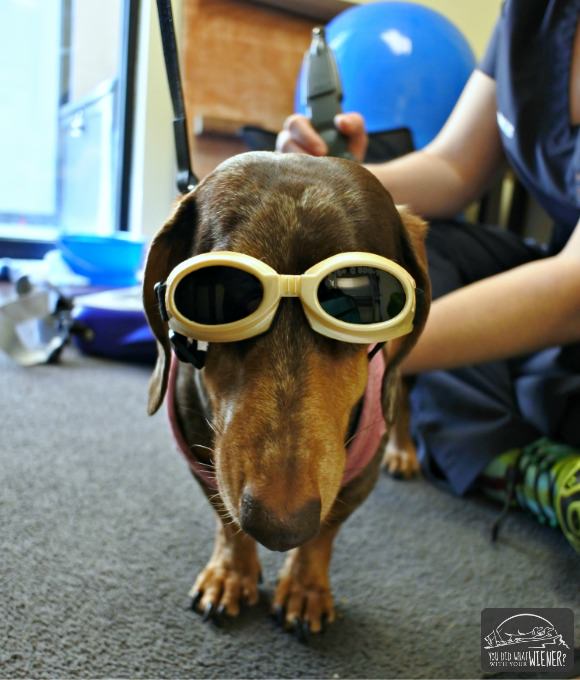Laurie's Blogs.
Jul 2019
Amazing Laser & an IVDD Case

This blog is about a recent case I treated that did amazingly well with (in part… or maybe in whole) to the credit of laser therapy. Let’s dive in.
The patient at hand is the cutest little miniature short haired dachshund. So, you can guess, that the presentation was that of an acute episode of IVDD. She had a history of a T-L region IVDD with surgical intervention. Then she had a second episode in the cranial lumbar spine. That time, the owner chose to not do surgery and came to the clinic for conservative management. Fast forward, we got her walking again and to about 90% of full function… (which since we didn’t see her after the surgery, might have been 100% better in regards to her post-surgical status!)
So, this client (awesome client… one of those owners that you hope you never stop seeing) rings the clinic in a panic. Her dog has gone down, can’t seem to use the left hind leg at all, and can’t walk…
We get her in, and I’m the therapist that has some space to see her. Now of course, I gave her the lecture that she should go to her vet, and that he/she would likely prescribe meds and refer her to the neurologist. However, point blank, the client said, I am not going down that route. I have started her on Metacam already and I am not willing to do surgery on this dog. I’m here for you guys to help me like you did the last time with her back. Okay, so that out of the way here’s what I found.
The dog was tender at L5 & L6, and there was increased muscle tone of the adjacent epaxials. Her tendon reflexes were significantly reduced in the left hind leg, and she was not weight bearing and could not be facilitated to stand on that leg. Her flexor withdrawal was diminished on the left as well. Her right hind leg was much less affected. So, my assumption was that of another IVDD episode.
Treatment on that day consisted of mobilizations, acupuncture, and laser therapy… using my LTS protocol (Laser The Snot out of it… or really the S. tends to stand for any other S word that within the context of the sentence would imply “Laser it way more than you would normally laser anything!”). For that I used both Superpulsed (2J/cm2) and Continuous wave (10J/cm2 @ 50% pulsed) laser with two of my Spectravet lasers using multiple, multiple, multiple points… so I can’t even tell you the total joules – sorry! The home program was to consist of hanging traction and tail pull traction. Additionally, I thought that more laser would be better and the owner was interested in renting our rental laser. So, I set her up with our rental laser. Our rental is a Respond 2400XL with the Wide Head multiprobe (superpulsed), and I advised the owner to hold it in place for 10 minutes on each side of the lumbar spine, thus delivering 20 Joules per cm2 from each of the diodes, twice a day. (20 joules x 8 diodes x 2= 340 Joules total of superpulsed laser daily). Now, if you know anything about laser and superpulsed in particular, this is a waaaay LTS protocol!!!
And???? So, when I saw this dog a full week later. She was walking. Back to 95% of her normal!! Of course, the owner was elated!! This was a ridiculously fast turnaround, and I attribute it to the massive dosing of laser! Yah… my hands are magical! But this… THIS was even more magical than my hands usually deliver!!!
At a recent staff meeting and therapist rounds at my clinic, I was asked, how did I come up with that dose? I’d like to take full credit, but I can’t. It comes from one of my absolute favourite research articles. Here’s the synopsis:
"Light, delivered transcutaneously, improves recovery after injury and suggests that light will be a useful treatment for human spinal cord injuries."
•Byrnes KR, Waynant RW, Ilev IK et al. (2005) ‘Light promotes regeneration and functional recovery and alters the immune response after spinal cord injury.’ Lasers Surg Med. 36: 171 – 185.
This study used an 810nm, 150mW laser and provided a daily dose of 1589 J/cm2 by administering the light for 2997 seconds/day. Treatment started 15 minutes after surgery and continued for 14 days.
Study dorsal hemisection on rats.
Results: (speculated 6% power penetration to the spinal cord depth). Significantly increased axonal number and distance regrowth. Suppressed immune cell activation and cytokine/chemokine expression.
Return of some aspects of function to baseline levels.
So, the moral of the story. Have a laser to rent out. Spectravet has a unit called The Zeus that would work for this. Respond’s 2400XL works for this as well. I think this could absolutely be a game changer for IVDD treatment (with or without surgery). As well, I think we will begin to hear more and more about conservative management of IVDD as owners (like my client) start to demand non-surgical options.
Go do some ‘miracle work' this week!
Cheers! Laurie


